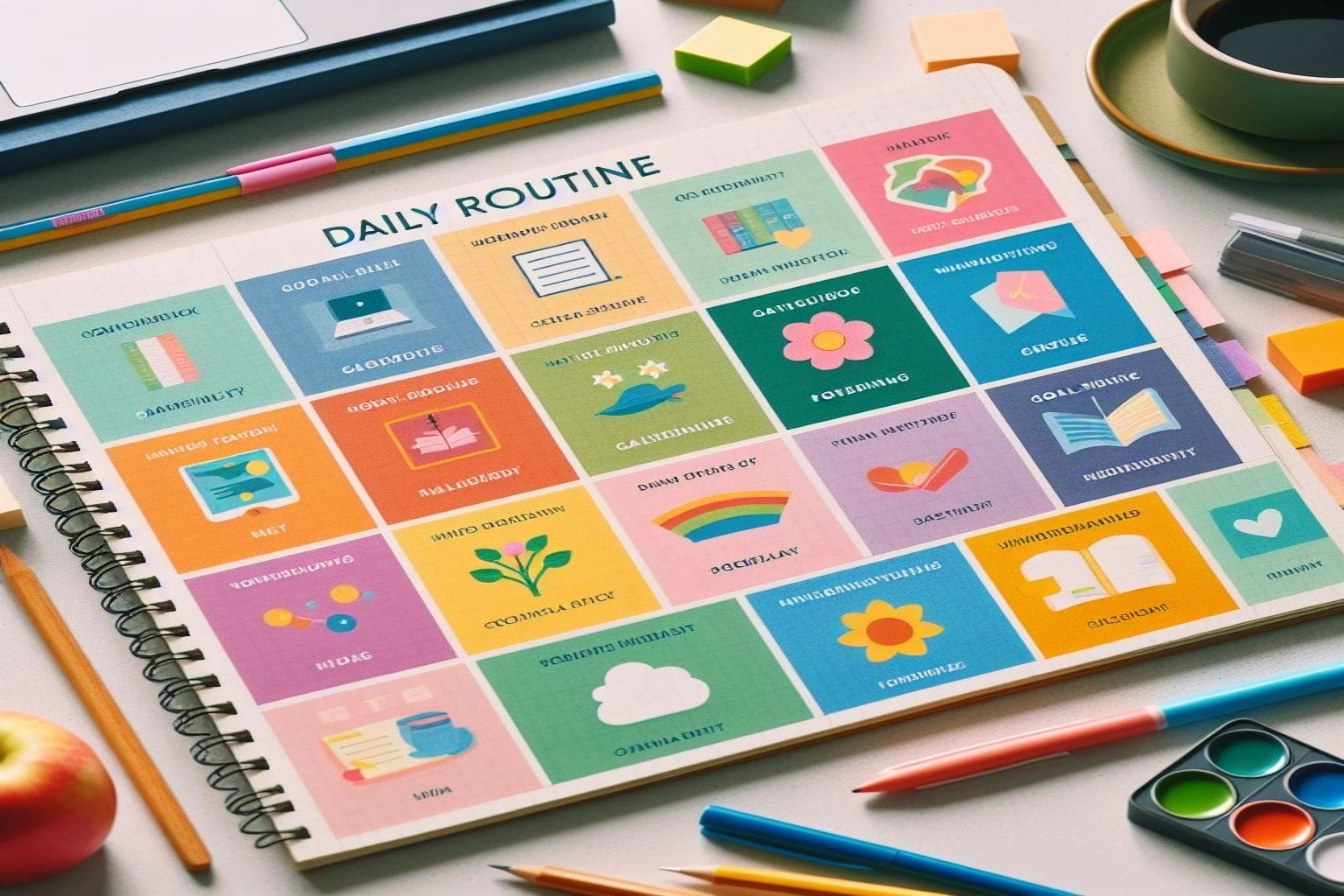
It’s common knowledge that self-care is important. Activities like exercise, nutritious eating, meditation, and engaging in fulfilling hobbies have clear mental and physical health benefits.
Yet, when life gets busy, our self-care is often the first thing to fall by the wayside. We tell ourselves we’ll make time for it tomorrow, only for tomorrow to arrive and that time to never materialize.
If this sounds familiar, you’re not alone. But with some intention and planning, you can break this cycle finally and design a routine that allows self-nourishment to become a consistent priority rather than an afterthought.
Step 1: Brainstorm Your Self-Care Dream List
The first step is getting crystal clear on what your ideal self-care routine actually includes. Start by brainstorming a master list of any and all activities that contribute to your overall wellbeing and happiness.
Really imagine your best self in detail – how do they spend each day and week? What healthy habits have they established that nourish them on every level?
As you brainstorm, don’t limit yourself by what seems practical based on your current schedule. This is about getting clear on your ideal scenario first.
Categories of self-care activities you may want to include:
Physical Health & Vitality
- Fitness – Include any form of movement you enjoy: yoga, running, sports, weights, etc.
- Nutrition – Healthy eating habits like meal prepping or learning new recipes
- Sleep – Prioritizing unwinding, good sleep hygiene
Emotional & Mental Wellbeing
- Meditation
- Journaling
- Therapy sessions
- Reading personal development books
Fun, Joy & Connection
- Hobbies like painting, puzzles, musical instruments
- Social activities – Meetups, standing events with friends
- Learning – New languages, instrument, skills
- Passion projects – Creative outlets, businesses on the side
Make your list as long and creative as desired! This will give you plenty of self-care ideas to draw from later when designing your routine.
Step 2: Categorize Activities into Buckets
Next, categorize each activity from your master list into one of 3 frequency buckets:
- Daily Activities: Habits you want to turn into consistent daily rituals
- Weekly Activities: Things you will realistically make time for once or twice a week
- Monthly Activities: Occasional treats to sprinkle in whenever there’s time
Having activities separated this way will allow you to be strategic when designing your schedule. Daily activities should be anchored firmly into each day first before layering on less frequent items.
Step 3: Designate Ideal Time Allotments
Go through your Daily Activities list item by item and denote your ideal amount of time to spend on each. Be specific here, as understanding exact time commitments will help immensely when trying to turn this list into an executable daily schedule.
For example:
- Yoga – 45 minutes
- Meditation – 20 minutes
- Meal prepping breakfast & lunch – 60 minutes
- Reading – 30 minutes
Knowing you want to dedicate 2.5 hours to these four tasks gives you a realistic sense of schedule space needed.
Step 4: Build Your Complete Ideal Day Schedule
Here’s where the fun begins! Start adding activities from your Daily list into a schedule template, incorporating the exact durations you defined for each.
Around these blocks, add in all usual daily must-do’s, including:
- Morning routine – Hygiene, breakfast, etc.
- Work hours
- Commute times
- Exercise & activity
- Meals & meal prep
- Personal obligations – Appointments, errands, etc.
- Evening wind down routine
Again, ignore total hours for now and just focus on building out your dream day packing it with everything mirrored in your Daily Activities list. Seeing the total picture will help you understand where the time crunches will be when making this actionable.
Step 5: Reality Check to 24 Hours
Chances are your ideal day totals far more than 24 hours! This was the fun blue sky visioning. Now comes the real work of editing it into something executable while retaining as many self-care items as possible.
Analyze each time block to find areas to trim while still feeling good about what remains:
Combine Categories: Can you meet two goals simultaneously? Example: Listen to audiobooks or podcasts during your commute.
Shorten Where Possible: Maybe your ideal workout is 60 minutes but 40 minutes is still beneficial. Or perhaps you can wake up 10 minutes earlier so your morning routine stays intact.
Consolidate Your Week: Can certain tasks happen just 2-3 times per week instead of daily? For example, shorten daily reading to 20 minutes and do longer 60 minute sessions only on weekends.
You may need to make some tough decisions or compromises, but retain your 1-2 non-negotiable priorities first when cutting, whatever they may be for you mentally and physically.
Step 6: Fold In Your Weekly Self-Care Activities
Your daily schedule now fits into a 24 hour window (or close to it!) while still feeling nourishing. Excellent! Now layer those key Weekly Activities you identified back into your calendar.
Find pockets of time where you can schedule these to occur every 7 days or so. Things like:
- Doing art projects
- Playing sports
- Exploring new hiking trails
- Meeting friends for coffee
Think through if certain days tend to be more open and pick reoccurring slots, i.e. Wednesday evenings are for painting date with friends or long trail runs Saturday morning before the day fills up.
Step 7: Implement Your Routine in Phases
With your complete daily and weekly schedule mapped out, it’s go time! But rather than trying to suddenly attempt your entire ambitious routine all at once, ease into in.
Phase 1) Start with just your Daily Activities routine first. Use a checklist template to track what you actually complete each day vs. what remains skipped for now. At first you likely won’t have the capacity or energy to do everything perfectly. And that’s ok! Start checking off small wins until you build momentum.
Phase 2) Over the next 1-2 weeks as your daily habits solidify, begin working those weekly activities into the allotted time slots you mapped out. Pay attention to when you start having to make trade-offs on daily items to accommodate the weekly adds. This may be a sign you need to reassess the full schedule’s sustainability long term.
Phase 3) After 1-2 months consistently working your holistic routine, you should have clear data on what slots and schedule configurations are working versus where you still struggle with follow through or bandwidth. Revisit your master blueprint, trim any true excess, and cement a routine you can maintain long term without constant frustration.
Adding reminder checklist templates into apps like Notion can help streamline tracking what activities actually happen daily versus aspirational items still left uncompleted overtime. Leverage these tools!
Through this phased approach, you build sustainable self-care momentum rather than burning out quick trying to overhaul everything overnight. Small consistent progress is key!
Step 8: Anchor Yourself in Your “Why”
Finally, the most critical step when adopting any new routine – especially one requiring substantial life adjustments – is reinforcing WHY you are expending this effort in the first place.
Take time reflecting on your motivation for finally prioritizing self-care. How will excelling in these areas improve your quality of life and who you are able to show up as?
Note down some reminder reasons and revisit anytime you feel your commitment wavering. Having a visible anchor for your “why” matters immensely.
Sample motivators could include:
- “I want to be an active, energized role model for my kids.”
- “I want radiant physical health so I can fully serve my purpose.”
- “I want to nourish inner peace and mental clarity to excel in my work.”
Also categorize motivators if helpful based on which area of self-care they tie to: Physical, Emotional, Community, Growth, etc. Refer back to your list when you need inspiration!
With the right planning and mindset shifts, you CAN implement an nourishing routine amidst life’s demands. Use the steps outlined to intentionally create space for self-care and sustainably work these activities into your weekly flow. The consistent effort is beyond worth it!







